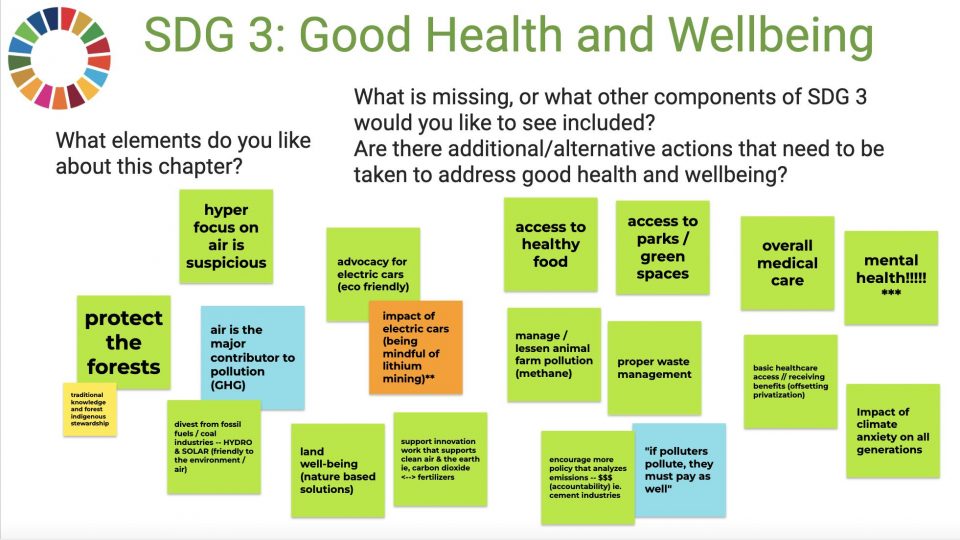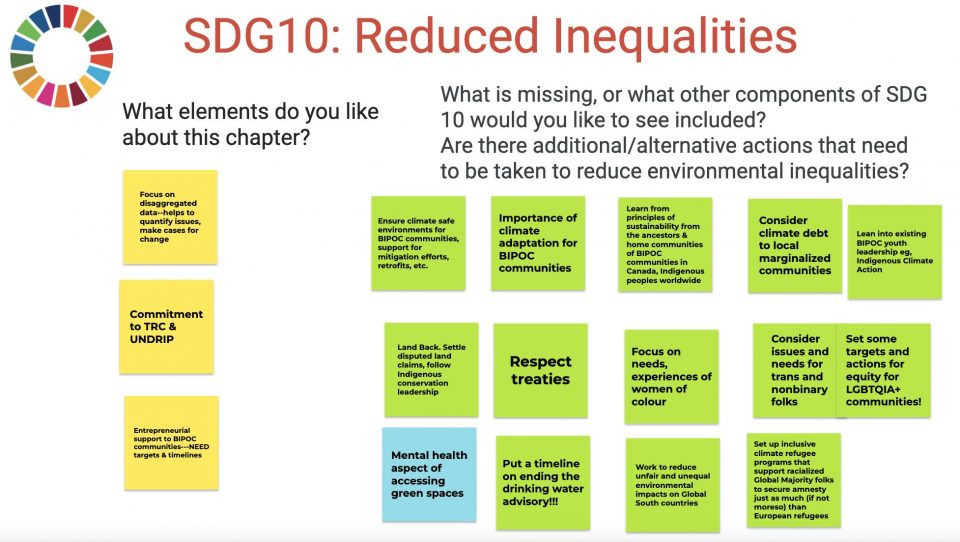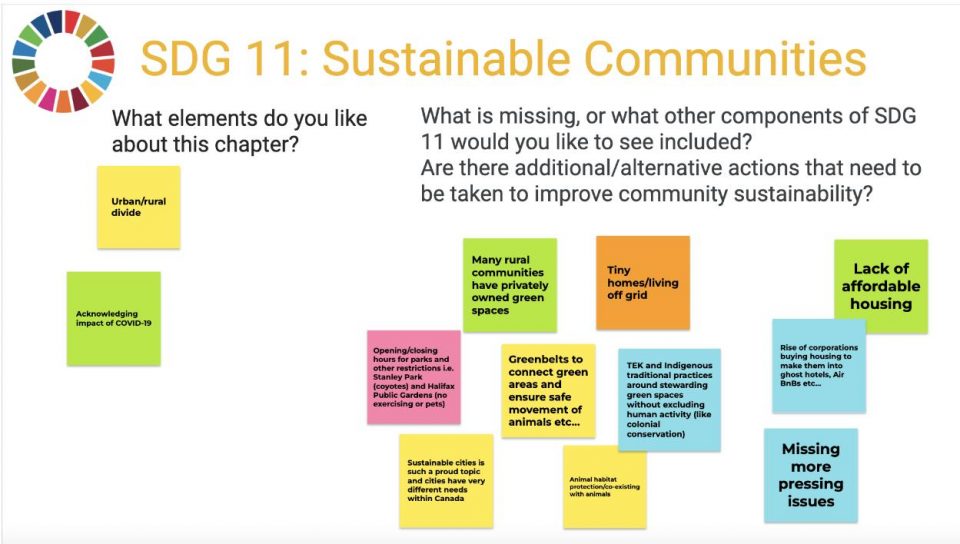On July 7th, 2022 Youth Climate Lab hosted a virtual engagement titled (YOU)th Achieving a Sustainable Future: Federal Sustainable Development Strategy Pop-Up Lab. This virtual event convened youth (aged 18 – 35) from across so-called Canada to discuss their priorities and dreams for the 2022 – 2026 Federal Sustainable Development Strategy (FSDS).
The goal overall was to align on and unpack some key priorities areas that speak to youth when it comes to the wider Sustainable Development Goals (SDGs) framework. We welcomed SDG advocate and consultant Alicia Richins to give a keynote on the development and progress of the SDGs thus far, emphasizing the interconnectedness of the goals and critical places for reflection, such as the need for more grounded efforts towards reconciliation with Indigenous peoples.
If this is your first time hearing about the “FSDS”, here is some context. Every three years the Government of Canada must publish a Federal Sustainable Development Strategy (FSDS), their whole-of-government plan for environmental and social prosperity using the United Nations Sustainable Development Goals (SDGs) framework. Given the connection between the SDGs and youth-led climate justice efforts, we wanted to mobilize a virtual space for youth to engage with this feedback process, and share personal experiences on the relevance of the SDGs and this strategy to climate-related work they are actively involved with or interested in. While the opportunity was given to provide general feedback to the draft FSDS and consultation process, due to limited time participants focused their discussion on three Chapters corresponding to the SDGs listed below:
- SDG 3 (Good Health and Well Being)
- SDG 10 (Reduced Inequalities)
- SDG 11 (Sustainable Communities)
Youth participated in facilitated breakout discussions centered on the following questions:
“What elements do you like about this chapter? What is missing, or what other components of this SDG would you like to see included? Are there additional/alternative actions that need to be taken to address this SDG?”. Captured below are the Jamboards from each Chapter, and some core recommendations and reflections that were included in the official feedback submission.
The chapters and indicators that youth were providing feedback on can be found on the official FSDS Consultation Page under Resources. For the full Feedback Submission submitted by Youth Climate Lab, you can check out this link.
 Jamboard from SDG 3 breakout room, from Youth Climate Lab’s FSDS feedback engagement
Jamboard from SDG 3 breakout room, from Youth Climate Lab’s FSDS feedback engagement
Chapter 3: Protect Canadians from Air Pollution and Harmful Substances
SDG 3: Good Health and Wellbeing
Health and well-being are directly involved with every aspect of our lives and the environment. We experience health and well-being in many ways including fostering community, having access to parks and other green spaces, having easy access to healthy food, accessible health care services, and many more.
As health and well-being are linked to every nuance and aspect of our lives and environment, tackling an issue this complex requires solutions and indicators that reflect this intricate relationship.
Therefore we ask why would the Canadian government not approach it holistically? Air quality and chemical pollution, while important, should not be the primary indicators of our personal, collective or environmental health. Using a limited scope of environmental indicators to measure overall health diminishes the roles of other environmental, socio-economic and political factors on our health and wellbeing.
Key takeaways:
- Scope for “health and wellbeing” needs to be expanded beyond air quality because health relies on a multitude of factors intertwined with the natural world
- Access to healthy food, green spaces, no barrier health care, and community are important factors that should be included
- Indigenous Traditional Knowledge, stewardship of the land, holistic approaches to health and Indigenous Ways of Knowing must guide solutions
- Integrate nature based solutions for air quality such as mass tree planting
- The mental health of youth needs to be included and addressed as climate anxiety and ecological grief take a toll on youth across Canada
- Encourage more policy regulations for Greenhouse Gas Emissions, enforcing the Polluter Pays Principle, with an emphasis on taxing large corporations that are emitting large amounts of pollution.
 Jamboard from SDG 10 breakout room, from Youth Climate Lab’s FSDS feedback engagement
Jamboard from SDG 10 breakout room, from Youth Climate Lab’s FSDS feedback engagement
Chapter 10: Take Action on Environmental Inequalities and Collaborate on Environmental and Natural Resource Management
SDG 10: Reduced Inequalities in and Between Countries
We appreciated how this chapter mentioned the importance of retrieving disaggregated data because it enables researchers to quantify issues and determine which social groups are disproportionately impacted. We also appreciated how supporting entrepreneurship for Black and Indigenous communities was mentioned as one of the implementation strategies because in order to reduce inequalities, racialized and marginalized communities need to be able to support themselves, their families, and communities. However, there are other key components that we believe were not thoroughly covered. For example, climate adaptation for racialized and Indigenous communities needs to be further investigated to explore how this may look like for Black, Indigenous, and People of Colour (BIPOC) communities. This chapter also fails to acknowledge and incorporate principles of sustainability from past ancestors and traditions to improve communication with, and understand the importance of climate change for BIPOC communities and the many diasporas that connect to BIPOC communities.
Key takeaways:
- Integrating traditional worldviews from Indigenous, and Black / POC communities within and beyond diasporas is non-negotiable
- Global consequences and considerations must be in mind when making decisions for climate and social justice
- Clear and specific targets are missing for 2SLGBTQQIA+ communities, and organizations, BIPOC women and gender minorities, climate refugees, as well as Indigenous communities and reserves affected by water advisories
- Race-based data is crucial to ensure barriers can be captured and overcome
We support the campaign to adopt Bill C-226: An Act respecting the development of a national strategy to assess, prevent and address environmental racism and to advance environmental justice into law.
 Jamboard from SDG 11 breakout room, from Youth Climate Lab’s FSDS feedback engagement
Jamboard from SDG 11 breakout room, from Youth Climate Lab’s FSDS feedback engagement
Chapter 11: Improve Access to Transportation, Parks and Green Spaces, as well as Cultural Heritage in Canada
SDG 11: Sustainable Cities and Communities
Approaching an issue as broad and complex as sustainable cities and communities is challenging.
The goals covered by the FSDS are important in multiple ways, including their discussion of the urban/rural divide and the acknowledgement of the impact of COVID-19 on the use of public transportation and green spaces. An incredibly important inclusion in the FSDS is that working with Indigenous peoples to conserve wildlife and their habitats through stewardship is a part of the implementation strategy. However, we feel that the goals are not comprehensive enough for addressing the issues being faced across Canadian cities and communities. Canada is a large and diverse place, which means that from city to city and community to community the needs of each are different, and what one community might consider to be their priority when it comes to sustainability, is a secondary consideration for another community. Ultimately, we feel that there are other pressing issues that need to be addressed, such as affordable housing.
Key takeaways:
- The FSDS does not address the diversity of needs that differ between communities and cities across Canada
- Affordable housing is a growing issue as large corporations buy up properties, and ghost hotels and AirBnb’s make it harder for people to secure reliable affordable long term housing
- Rules and restrictions on when and how green spaces are accessed and used creates barriers for those trying to utilize these spaces – while the FSDS highlights the rural/urban divide in terms of access to green spaces, it does not highlight the class elements such as gated parks and rules that alienate many people
- We need more emphasis on the need for greenbelt development and protection, which would allow for the unimpeded and safe movement of wildlife and natural ecological processes
- Indigenous Traditional Ecological Knowledge approaches are necessary for ecological maintenance of green spaces.
The event closed with the groups sharing back on their key learnings and YCL staff directing them where to go to participate further in the consultation process. There is gratitude for being able to think critically about the SDGs in an intentional way, and being able to contribute to something actionable, such as a feedback submission to the FSDS.
Youth continue to step up as leaders in a generation of climate inaction, shaking up the status quo to accelerate climate justice in whatever context is most relevant and meaningful to them.
The continued development of federal-level strategies that include and incorporate youth feedback is important. As well, deepening one’s understanding of the SDGs and all of the interconnected relationships, especially as a young person, is one of many important steps for achieving effective climate action.
Youth Climate Lab (YCL) is a Canada-based, global non-profit organization of youth mobilizing youth to create just, climate-resilient futures. We equip youth with skills, financial access and policy knowledge to take leadership in the climate movement. This work is realized through the design of innovative tools, programs, and spaces.
The contents of this blog was co-authored by the following Youth Climate Lab staff:
Celeste Alcena, Cameron Armstrong, Mikayla Eastman, Sabrina Guzman Skotnitsky, Rose Schoonhoven, Rufaro Muzorewa
This engagement event and related works are funded by the Government of Canada’s Sustainable Development Goals Program, and has been made possible thanks to our partners, Alliance 2030 and the Community Foundations of Canada.


